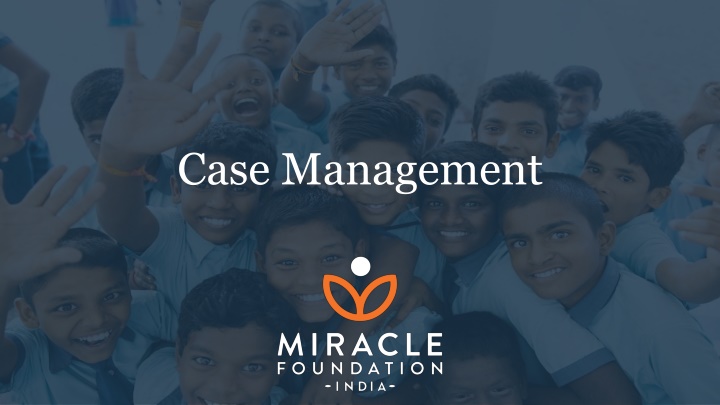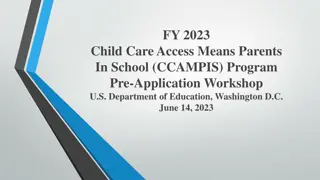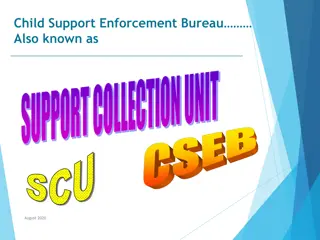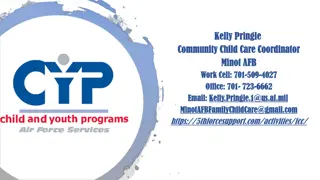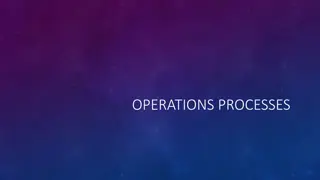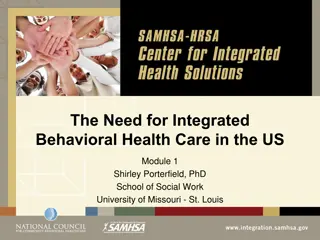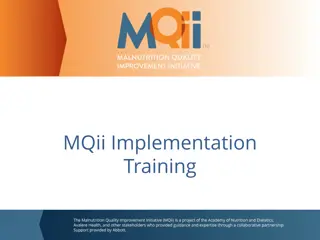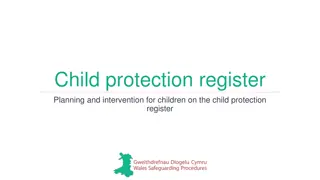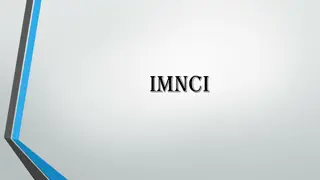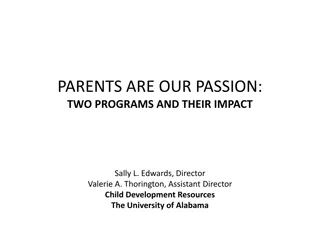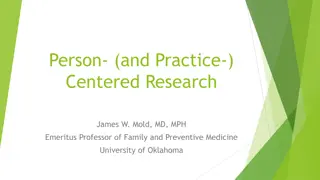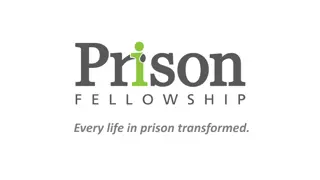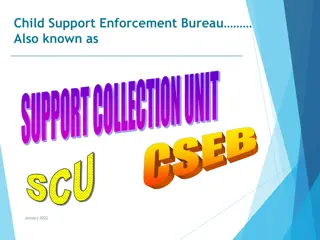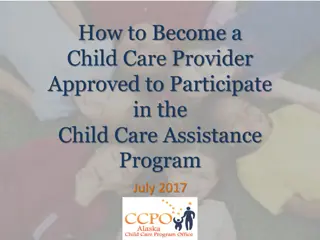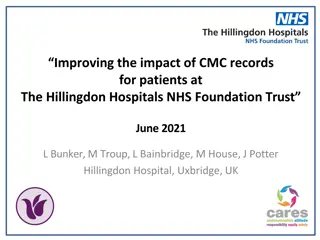Child-Centered Case Management: Transforming Lives Through Care and Support
Providing consistent and on-going support to children and families, child-centered case management aims to meet their goals through individualized care plans. Case managers work collaboratively with various stakeholders to ensure the best interests of the child are prioritized, following principles of accountability, cultural sensitivity, and respect for confidentiality. The process involves developing comprehensive care plans based on assessments and fostering trusting relationships with children and families.
Download Presentation

Please find below an Image/Link to download the presentation.
The content on the website is provided AS IS for your information and personal use only. It may not be sold, licensed, or shared on other websites without obtaining consent from the author.If you encounter any issues during the download, it is possible that the publisher has removed the file from their server.
You are allowed to download the files provided on this website for personal or commercial use, subject to the condition that they are used lawfully. All files are the property of their respective owners.
The content on the website is provided AS IS for your information and personal use only. It may not be sold, licensed, or shared on other websites without obtaining consent from the author.
E N D
Presentation Transcript
01 Definition of Case Management Transforming lives through individualized care and services so children and families can meet their goals @Miracle Foundation 2021
02 Child-Centered Case Management Purpose: Consistent and on-going support to child and family through each step of the process Documentation of assessments and records to develop care plans and make sound decisions regarding reintegration Core Values: Engage children in appropriate ways at each step Protect children from harm Ensure that decisions are made in their best interests image: Stock Photos @Miracle Foundation 2021
03 Case Manager In places where very few professional social workers are available, lay people such as community leaders/members can be trained to act as case managers. Professional responsible for coordinating the overall care delivered to children and families following a systematic case management process. Case Managers work with family members, friends, educators, psychologists, health care experts, and others involved in the child s life to meet the needs of each child. This professional must have: the ability to develop trusting relationships with the children and families a solid understanding of the community, cultural customs, local language @Miracle Foundation 2021
04 Principles of Case Management Do No Harm Prioritize the Best Interests of the Child Ensure Accountability take responsibility for your actions Based on Sound Knowledge of Child Development and Child Rights Child s Right to be Heard, Participate, and their Views taken Seriously involve children and seek out their opinions Provide Culturally Appropriate Processes and Services Seek Informed Consent Respect Confidentiality Work in Non-discriminatory Way Maintain Professional Boundaries image: Stock Photos @Miracle Foundation 2021
05 Case Management Plan A comprehensive care plan for a child that describes: Child s and family s strengths, challenges, needs, and desires as determined from the child and family assessments Plans for support and interventions to be implemented Measurable goals, time frames to achieve them, and resources to be used image: Stock Photos @Miracle Foundation 2021
06 Case Management Process Intake/ Admission Close Case Follow-Up/ Evaluate Assess Plan Implement The process is highly individualized and focused on the child. Note that the process is presented as steps, but it is often non-linear and can involve several steps happening at the same time or circling back in the process. @Miracle Foundation 2021
07 Case Management flow Chart @Miracle Foundation 2021
08 Meet Riya We will use a fictional case study of a child to walk through the steps of case management. Riya is a 6 year old girl who is entering Caring Child Care Institution (CCI) because her father recently passed away, and her mother, a domestic worker, can t take care of Riya on her own because her work keeps her away from home. Riya s mother passes Caring CCI on her way to work every day and sees all the children getting ready for school. She decided it would be the best place for her daughter at this time since Riya would get the basics of food and clothing, they could support her education, and she would get good care outside of school hours. Though it was a really difficult decision, Riya s mother felt it was the best option she had for Riya to get the care she needed. She told Riya about her plan and asked her to pack up a few items, since she would be dropping Riya off on her way to work the next day. @Miracle Foundation 2021
09 Step One: Intake/Admission Riya is not able to return immediately to her family home so short-term placement was needed in a CCI until her family situation could be strengthened. When Riya arrived at Caring CCI, the staff took the following steps: Looked for concerns that needed to be addressed immediately such as health issues, signs of abuse, etc. Collected all required documents and presented to the appropriate authorities (India: JJA Form 17 to CWC within 24 hours) If Riya had been lost or abandoned, they would have notified police or other authorities (India: CCI must submit Form 17 to local police) Determined immediate, short-term placement into CCI @Miracle Foundation 2021
10 Step Two: Assessment Once the Intake process was completed, the Caring CCI Case Manager turned her focus to understanding more about Riya s strengths and challenges in all of the child development areas, as well as learning about her family s current situation. This process included: Identifying Riya s interests, concerns, needs, strengths, and her support system Collaborating with family members and professionals in Riya s life (health, education, mental health, etc.) Completing a comprehensive child care plan to address her needs and identify potential interventions India: Child Case History - JJA Form 43 and Individual Care Plan (ICP) JJA Form 7 within one month Assessing the safety of the family environment through Red Flag items identified on the Home Thrive ScaleTM image: Stock Photos Determining if reintegration is possible after contact with family India: Social Investigation Report JJA Form 22 within 15 days @Miracle Foundation 2021
11 Step Three: Planning Armed with knowledge about Riya s and her family s strengths and challenges, the case manager turned to child-focused decision making and service planning to address Riya s and her mother s needs. It was determined that Riya s mom could support her if childcare was made available while she was at work, and emotional support was provided to both regarding the loss of their father/husband. She utilized the Home Thrive ScaleTM to provide a clearer picture of services needed to surround Riya with security and an opportunity to thrive in her family home. The Home Thrive ScaleTM outlines: Riya s and her mom s thoughts about living together once again Needs and strengths of Riya and her mom, and services required Extended family, community members, organizations that could provide support so Riya can stay home Specific, measurable, and time-bound goals that will be monitored A plan for permanency, so Riya can be confident that her family home is her forever home @Miracle Foundation 2021
12 Step Four: Implementation The case manager found that Riya s aunt could care for her outside of school hours if transportation could be provided to her home. The case manager was able to recruit several families with children in the same school as Riya to help with transportation issues. The case manager also arranged for Riya and her mother to receive grief counseling to help them through this difficult time after the loss of their father and husband. Now that a determination has been made regarding reintegration for Riya, it is time for the Case Manager to coordinate the implementation of support and follow the progress. This includes: Preparing Riya and her mom for her return working through emotions related to the separation and reunification Linking them to their support network and community services The case manager keeps Riya and her mom involved and updated throughout the process. @Miracle Foundation 2021
13 Step Five: Follow-Up Riya and her mother are active participants in evaluating the support they receive. Riya is enjoying school and her mom feels more ready to take on responsibility knowing she has people to reach out to. Together, they celebrate successes and voice their concerns when they face a challenge. The Case Manager must connect with Riya and her mother frequently. The primary objective is to ensure that they are finding the support helpful, to understand any issues or concerns, and to revise the care plan as needed. Regular calls and visits by the Case Manager as well as from kin and community members assure Riya and her mom that they are not alone. Conversations with teachers, healthcare providers offer additional insight into the family s adjustment The Home Thrive ScaleTMshould be completed at every follow up contact, and plans should be modified as needed to help Riya and her mother build upon their strengths and continue to develop their coping skills. Adjustment and settling back in takes time, and the Case Manager is there to help Riya and her mother through the process as they work to achieve their goals. @Miracle Foundation 2021
14 Home Thrive ScaleTM The Home Thrive Scale is available in paper form or as an automated version accessible by cell phone or tablet. Ensures serious Safety concerns (RED FLAGS)* related to reintegration are addressed as a priority Allows us to track the quality of the family s reintegration over time. Family s wellbeing is assessed under 5 domains: Family and Social Relationships Household Economy Living Conditions Education Health and Mental Health Milestones under each right are rated on a scale of 1 (in crisis needs immediate attention) to 4 (thriving no attention needed) Detailed intervention plans are created for each milestone that needs attention Progress is tracked by domain over time @Miracle Foundation 2021
15 Graphing Results of the Home Thrive ScaleTM Riya and her mother had a pre- reintegration score of 89% in Household Economy due to lack of access to childcare. Now that Riya s aunt is providing that care, the score has improved to 100%. Family & Social Relationships 100% 90% 80% 70% 60% 50% In addition, both Riya and her mom were grieving the loss of their father/husband, and it was impacting the relationship between them and Riya s ability to concentrate at school. Bolstered by grief counseling, their Family and Social Relationships and Health/Mental Health domains improved significantly. 40% Health & Mental Health Household Economy 30% 20% 10% 0% Education Living Conditions Finally, the Living Conditions domain improved due to a safer home environment for Riya. Goal = 100% Pre-Reintegration At Reintegration 6 Month Follow-Up @Miracle Foundation 2021
16 Step Six: Close Casea Cases are typically closed because: Goals of the plan have been met and long-term care is assured Permanency goal has been met Child can successfully live independently at age 18 Care of child has been transferred to another agency or organization Riya and her mother have been happily living together once again for over a year. They still have some growth they would like to accomplish, so the Case Manager is still there to support them. They have noted that now that they are feeling stronger, they would like to help others in their community as they work through difficult situations. Even after closure, the child and family should always know who to reach out to for assistance in the future. @Miracle Foundation 2021
